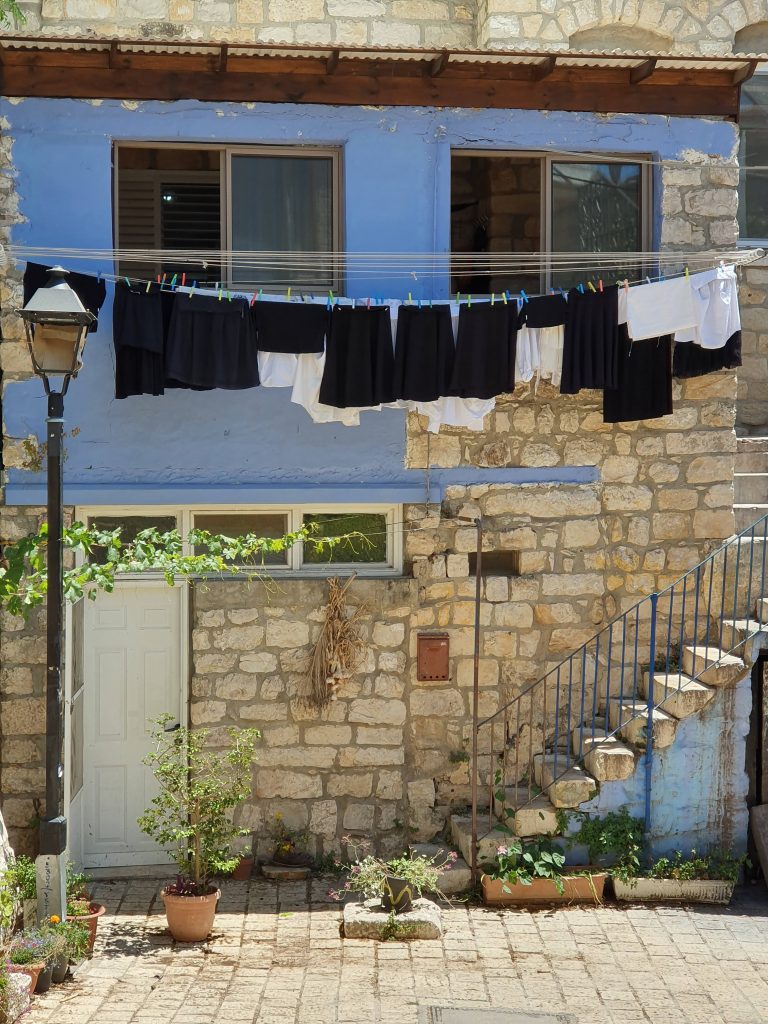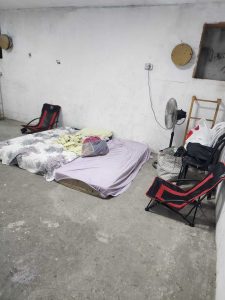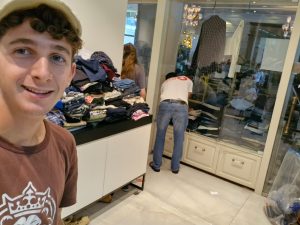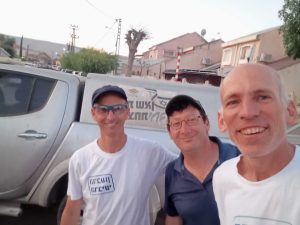When we think about the Jewish Ultra-Orthodox community, the prevailing image is often one of stark simplicity. This perception is largely influenced by how we observe them in public and media representations, as community members adhere to a dress code characterized by modest attire, typically composed of dark, monochromatic colors, such as black pants or skirts paired with white button-down shirts. This dress code is consistently adhered to in everyday life, and it becomes even more prominent during Shabbat, holidays, and special occasions when they don formal suits and traditional garments. The community’s distinctive visual identity is synonymous with black and white, as they quite literally clothe themselves in these colors.
We often engage in oversimplified, dichotomous discussions about them, referring to the Jewish Ultra-Orthodox community in black and white terms. Those of us who are not part of the Ultra-Orthodox community in Israel, and often non-Ultra-Orthodox individuals around the world, tend to frame these conversations in stark contrasts. We paint ourselves in white, symbolizing the ‘good,’ while portraying them in black, signifying the ‘bad.’ We argue that we contribute significantly to the country and society at large, whereas they appear to be less engaged. We claim prosperity, while they seem to struggle economically. We perceive ourselves as forward-thinking, while they appear to be bound to tradition and the past. We assert our freedom, contrasting it with their adherence to a ‘higher power’ and rabbinical authority. We highlight our military service, which they typically don’t participate in. We emphasize the education of our children, whereas their children seem to receive a different form of schooling. We point out their larger families, their sectorial political power, and we accuse them of prioritizing their own interests. These narratives fuel fears that they might eventually dominate our country. This black and white discourse has led to the creation of a menacing, colossal black demon that we are urged to fear.
It’s widely acknowledged that the emergence of Jewish Ultra-Orthodoxy, approximately 150 years ago, can be traced back to a reaction against the challenges posed by modernity and enlightenment. This reaction isn’t limited to modernity alone but extends to its expression in various other Jewish movements, such as the reform and assimilation movements. There’s a story that illustrates this message: An Ultra-Orthodox Jewish man seeks guidance on Jewish law from his Rabbi, visiting the Rabbi’s home. He asks, “The lightbulb in my house has burnt out. What should I do? Can I change it?” The Rabbi is taken aback by the question and promptly responds, “Change?! Not even a lightbulb!”
While it may be tempting to categorize the Jewish Ultra-Orthodox community, whether in Israel, Brooklyn, Montreal, Antwerp, London, or elsewhere, in stark black and white terms, a closer examination reveals that there are numerous shades of nuance within this community. Those who delve deeper will discover that it’s not a simplistic dichotomy but a vibrant tapestry of colors. In the end, we are talking about individuals who are an integral part of our extended family, and deep down, we all understand that every human story, whether it pertains to an individual, group, or community, is a complex, ever-evolving narrative filled with a myriad of colors, far removed from the constraints of black and white.
Despite the increasing presence of the Ultra-Orthodox community in Israel, breaking away from the oversimplified, black and white narrative and embracing the multifaceted aspects of this community has proven to be a formidable challenge for the other segments of Israeli society.[1] Let me be clear, I don’t place blame on anyone, as I, too, am not exempt from contributing to this issue. There are several aspects of the Ultra-Orthodox community that trouble me and quickly ignite my frustration. Throughout my life, I’ve had continuous encounters with Ultra-Orthodox Jews, with many of my extended family members leading Haredi lifestyles. Numerous significant events like Bar Mitzvahs, weddings, and family gatherings in my life have been characterized by this stark ‘Black and White’ contrast. I would like to share a couple of stories with the intention of delving further into this topic in the future.
When I was 12, shortly before my Bar Mitzvah, my parents arranged for me to spend a Shabbat with two cousins who were brothers in the city of Bnei Brak, not far from Tel Aviv. For many years, Bnei Brak has been a stronghold of the Ultra-Orthodox community and leadership in Israel. One of my cousins was a Rabbi and a teacher, and his brother, who was single at the time, was a student at the prestigious Litvak Yeshiva, Ponevezh. The purpose of this Shabbat visit was to help me learn and prepare my Bar Mitzvah drash or speech, as is customary in our circles.
I suppose we accomplished that mission because I did end up delivering a Bar Mitzvah speech a couple of weeks later. However, to claim that I remember anything from that speech would be a gross misrepresentation. What I do remember vividly is sleeping on a mattress in the dormitory, amidst hundreds of yeshiva students. I recall entering the Beit Midrash, the study hall, and being greeted by the cacophony of hundreds of students engaged in paired study (havruta), which instantly fell silent as Rabbi Elazar Menachem Man Shach entered the room and made his way to his lectern at the front.
I can still picture the Shabbat prayers and the profound sense of anticipation as we lined up to receive a blessing from the esteemed Rabbi. That evening, I walked to the Vishnitz Tisch, also known as the Rebbe’s Table, where thousands of Hasidim swayed back and forth on their stands, immersed in harmonious nigun (melody) and song. They watched their Rebbe seated at the far end of a lengthy table, distributing Shiayim, the leftovers of the meal, for them to partake in. The juxtaposition of the sounds of study and prayer in a Beit Midrash teeming with students and the melodic chants and songs in the presence of the Rebbe left an indelible impression on me. It’s an experience that’s challenging to convey to those who haven’t lived through it themselves.
Several years later, I embarked on a gap year between completing high school and beginning my military service, and I found myself in the ancient city of Tzfat. Amidst my quest for knowledge and personal growth, I established a daily routine. Every afternoon, between the Mincha and Maariv prayers (the afternoon and evening prayers), I would sit at a table with two Breslav Hasidim, engrossed in the study of Kitvei Rabbeinu, the works of Rabbi Nachman of Breslov. This newfound friendship extended into my Shabbat experiences in Tzfat. I became a regular at their place in the main sanctuary of the Breslov community during Friday night Kabbalat Shabbat. The collective sounds of prayer and nigun enveloped the expansive room, captivating everyone within, from the youngest children to the adults. Midway through the service, a joyous chain of people holding hands would form, meandering through the room and between tables, singing and dancing to the tune of “Bar Yochai.” This heartwarming tradition repeated itself at the conclusion of the service with “Sab’enu Mituvach,” culminating in a line to greet Rabbi Elazar Mordechai Koenig, may his memory be a blessing, with wishes of Shabbat Shalom. As for the extent of the knowledge I retained from those days spent at the learning table between Mincha and Maariv back in 1997, it may have faded over time. Nevertheless, the resounding echoes of a vibrant Beit Midrash engaged in study and a sanctuary resonating with song and prayer remain etched in my memory, an enduring testament to those remarkable experiences.
The resonance of study in the Beit Midrash, the harmonious sounds of community songs and prayers, has always stirred a deep excitement within me. This remains true even during the years I spent immersed in the solitude of quiet study on the fifth floor of the library at Hebrew University on Mount Scopus. From time to time, I find myself drawn back to those sounds, either physically or in my thoughts. They meet me in various life experiences, reinvigorate my spirit, and infuse my soul with vibrant hues.
For slightly more than a decade now, Israeli popular culture has been committed to presenting the Haredi community to the broader Israeli public in all its vibrant colors. Films like “Ushpizin” (2004) and “Fill the Void” (2012) have brought this community to the big screen. Television series like “Shtisel” (2013) have found a global audience on platforms like Netflix, exposing this way of life to a large and engaged viewership worldwide. Ultra-Orthodox culture is also showcased in literature, articles, and music. These portrayals are not without their inaccuracies, critiques, and criticisms. They often lack the cooperation or consultation of community members. Nonetheless, they serve as windows into the broader community, shedding light on its internal challenges and external influences. Most importantly, they infuse a wealth of color, offering myriad shades to a community that is often perceived in simple black and white.
The sounds of learning, singing, and prayer are just one facet, albeit one with many nuances. There’s much more to explore. As members of the Jewish people, it is our duty to seek out and embrace the full spectrum of colors within the Ultra-Orthodox Haredi community, for numerous compelling reasons. This endeavor is essential not only to challenge our tendency to see the community in monochromatic terms but also to foster a respectful dialogue that paves the way for mutual growth and collaboration in the future.
Stay tuned for the unfolding array of “Black and White.”
[1] See President Rivlin’s “Four Tribes” Initiative. https://www.runi.ac.il/en/research-institutes/government/ips/activities/4tribes/




